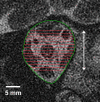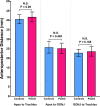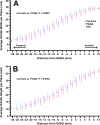Orbital Fat Volume After Treatment with Topical Prostaglandin Agonists
- PMID: 32455434
- PMCID: PMC7405708
- DOI: 10.1167/iovs.61.5.46
Orbital Fat Volume After Treatment with Topical Prostaglandin Agonists
Abstract
Purpose: Topical prostaglandin analogs (PGAs) are common treatment for primary open-angle glaucoma (POAG) but reportedly may cause adnexal fat atrophy. We asked if patients with POAG treated with PGAs have abnormalities in orbital fat volume (OFV).
Methods: We studied 23 subjects with POAG who had never experienced intraocular pressure (IOP) exceeding 21 mm Hg and were treated long term with PGAs, in comparison with 21 age-matched controls. Orbital volume, non-fat orbital tissue volume, and OFV were measured using high-resolution magnetic resonance imaging.
Results: Subjects with POAG had been treated with PGAs for 39 ± 19 months (SD) and were all treated within the 4 months preceding study. In the region from trochlea to orbital apex, OFV in POAG was significantly less at 9.8 ± 1.9 mL than in the control subjects at 11.1 ± 1.3 mL (P = 0.019). However, between the globe-optic nerve junction (GONJ) and trochlea, OFV was similar in both groups. Width and cross sectional area of the bony orbit were significantly smaller in POAG than in controls (P < 0.0001). Posterior to the GONJ, the average orbital cross-sectional area was 68.2 mm2 smaller, and the orbital width averaged 1.5 mm smaller throughout the orbit, in patients with POAG than in controls.
Conclusions: Patients with POAG who have been treated with PGAs have lower overall OFV than controls, but OFV in the anterior orbit is similar in both groups. Lower overall OFV in POAG may be a primary association of this disorder with a horizontally narrower bony orbit, which may be a risk factor for POAG at nonelevated IOPs.
Conflict of interest statement
Disclosure:
Figures









Similar articles
-
The impact of chronic use of prostaglandin analogues on the biomechanical properties of the cornea in patients with primary open-angle glaucoma.Br J Ophthalmol. 2017 Feb;101(2):120-125. doi: 10.1136/bjophthalmol-2016-308432. Epub 2016 May 9. Br J Ophthalmol. 2017. PMID: 27162226 Free PMC article.
-
Orbital cerebrospinal fluid space in glaucoma: the Beijing intracranial and intraocular pressure (iCOP) study.Ophthalmology. 2012 Oct;119(10):2065-2073.e1. doi: 10.1016/j.ophtha.2012.03.054. Epub 2012 Jun 28. Ophthalmology. 2012. PMID: 22749084
-
Association between topical prostaglandin analog use and development of choroidal neovascular membranes in patients with concurrent glaucoma and age-related macular degeneration.J Ocul Pharmacol Ther. 2006 Apr;22(2):139-44. doi: 10.1089/jop.2006.22.139. J Ocul Pharmacol Ther. 2006. PMID: 16722800
-
The use of prostaglandin analogs in the uveitic patient.Semin Ophthalmol. 2011 Jul-Sep;26(4-5):285-9. doi: 10.3109/08820538.2011.588650. Semin Ophthalmol. 2011. PMID: 21958176 Review.
-
Investigational drugs targeting prostaglandin receptors for the treatment of glaucoma.Expert Opin Investig Drugs. 2018 Oct;27(10):777-785. doi: 10.1080/13543784.2018.1526279. Epub 2018 Sep 25. Expert Opin Investig Drugs. 2018. PMID: 30227753 Review.
Cited by
-
Adduction-Induced Strain on the Optic Nerve in Primary Open Angle Glaucoma at Normal Intraocular Pressure.Curr Eye Res. 2021 Apr;46(4):568-578. doi: 10.1080/02713683.2020.1817491. Epub 2020 Sep 11. Curr Eye Res. 2021. PMID: 32911989 Free PMC article.
-
Evaluation of the Effect of Topical Prostaglandin Analog Treatment on Orbital Structures in Open-Angle Glaucoma with Computed Tomography.J Clin Med. 2024 Sep 28;13(19):5808. doi: 10.3390/jcm13195808. J Clin Med. 2024. PMID: 39407871 Free PMC article.

